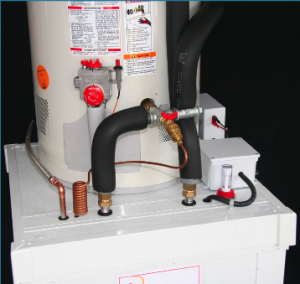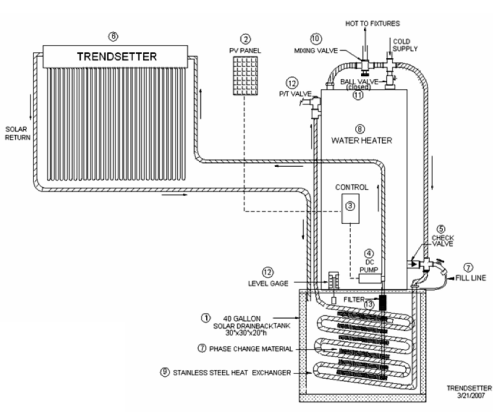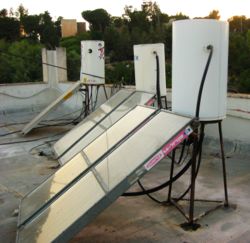|
 Sunshine is a free source of energy
which makes solar water heaters an extremely
viable home appliance.
Sunshine is a free source of energy
which makes solar water heaters an extremely
viable home appliance.
A solar water heating system works by
capturing the energy from the sun and
converting it to energy which heats the
water, there are two basic types of solar
heating systems for household water. The
first is an active solar water heating
system which circulates the hot water
through the household water system using
a water pump, the second type of solar
water system is passive which works much
like your electric hot water system in
that it holds the solar heated water in
a central tank and then feeds it to the
destination using household water pressure.
The setup of a home solar water heating
system is usually configured as a collector
(see below) which captures the energy
from the sun and transfers that energy
to the water in the form of heat, the
heated water then flows down to a heat
exchangers which, in a solar water preheating
system is a tank that holds water or other
fluids. This solar preheater is feed directly
from the solar collector and usually contains
a set of copper pipes coiled and submersed
into the fluid, these copper coils allow
the primary water heater to circulate
it's water source through the solar water
preheating system without contaminating
the household water source. As the water
from the primary water heater flows through
the coil in the preheater, the water is
heated through natural convection and
then returned to the primary water heater's
storage tank. This cycle takes place 365
days a year and significantly cuts down
on the average household electric bill.
There are generally three types of solar
collectors used for residential solar
water heating applications:
Flat-plate collector
Glazed flat-plate collectors are insulated,
weatherproofed boxes that contain a dark
absorber plate under one or more glass
or plastic (polymer) covers. Unglazed
flat-plate collectors—typically
used for solar pool heating—have
a dark absorber plate, made of metal or
polymer, without a cover or enclosure.
Integral collector-storage systems
Also known as ICS or batch systems, they
feature one or more black tanks or tubes
in an insulated, glazed box. Cold water
first passes through the solar collector,
which preheats the water. The water then
continues on to the conventional backup
water heater, providing a reliable source
of hot water. They should be installed
only in mild-freeze climates because the
outdoor pipes could freeze in severe,
cold weather.
Evacuated-tube solar collectors
They feature parallel rows of transparent
glass tubes. Each tube contains a glass
outer tube and metal absorber tube attached
to a fin. The fin's coating absorbs solar
energy but inhibits radiative heat loss.
These collectors are used more frequently
for U.S. commercial applications.
Active solar water heating systems come
in two types:
The direct circulation systems pumps
water through the collector directly into
the home and does not use a preheater
tank or a primary electric water heater,
this type of system may work well in southern
Nevada and other places where it rarely
freezes but in colder climates they generally
perform poorly.
The indirect solar water heating system
pumps water or heat-transfer fluid through
the collector into a heat exchanger, much
like Trendsetter's Piggy Back™ solar
water heating system which can be configured
as passive or active. The indirect system
of solar heating is preferred in almost
all climates from desert heat to climates
prone to freezing temperatures.
When cost is an issue, the passive solar
water heating system is a good option
over an active system. Although a passive
solar heater is less efficient than an
active solar water heater, the passive
system can be more reliable and outlast
an active system. The two basic types
of passive solar water systems are:
Integral collector-storage passive
systems
These work best in areas where temperatures
rarely fall below freezing. They also
work well in households with significant
daytime and evening hot-water needs.
Thermosyphon systems
Water flows through the system when warm
water rises as cooler water sinks. The
collector must be installed below the
storage tank so that warm water will rise
into the tank. These systems are reliable,
but contractors must pay careful attention
to the roof design because of the heavy
storage tank. They are usually more expensive
than integral collector-storage passive
systems.
With almost all solar water heating systems
a primary or backup water heater is required
when there are periods of low solar activity
such as night or long lasting cloudy days
or during increased demand. The backup
water heater is usually an electric water
heater which must run when solar heated
water is not available.
One of the better solar water systems
systems use a collector which feeds a
heat exchanger which preheats the actual
electric water heater. What this does
is to allow for the backup system to be
directly heated by the solar hot water
heating system and still be able to take
over when the water temperature falls
below proper levels.
 The generic description of the system
is classified as a drain-back system.
The non pressurized solar storage tank
(1) contains 40 gallons of tap water initially
filled from a garden hose or the fill
line. The level gage (12) shows when the
tank is filled to the proper level. The
tank water does not mix with the potable
hot water discharged at the fixtures.
When the sun comes up, the PV panel (2)
receives sunlight. The controller (3)
conditions the voltage and provides power
to the dc pump (4) for a soft start and
maximizes the power output of the PV panel
(2). The water in the tank gradually heats
up as water is circulated from the tank
through the 5 micron filter (13) to the
solar collector (6) and back to the tank.
The phase change material (7) will melt
as the water in the tank begins to exceed
115oF. This process will significantly
improve the thermal performance of the
system.
Transfer of Solar Heat to the
Water Heater
Cold water normally enters the water heater
(8) through the cold inlet at the top
of the tank. The ball valve (11) blocks
off this path and diverts the cold water
through the heat exchanger (9) to “solar
heat” the water before it enters
the tank at the P&T valve (12) location
near the top of the tank. The check valve
(5) prevents the cold water from entering
the tank at the discharge port at the
bottom of the tank.
Natural Thermal Convection
The water heater (8) is also passively
thermally coupled through the heat exchanger
connections at locations P&T valve
(12) and check valve (5). The normal temperature
of water heater (8) is 120oF. Normally
the temperature at the bottom of a tank
type water heater would be approximately
90oF when the top of the tank is 120oF.
Hot water wants to rise to the top because
it is less dense than cold water. We use
this principle to transfer the solar energy
from the solar storage tank (1) to the
water heater (8) once the temperature
in the solar tank exceeds the water temperature
at the bottom of the water heater tank
Regular maintenance on simple systems
can be as infrequent as every 3 to 5 years,
preferably by a solar contractor. Systems
with electrical components usually require
a replacement part after or two after
10 years. 
Benefits of Solar Water Heating
- Reduce water heating portion of utility bill by as much as 90%
- No water heater storage tanks to replace ever
- $2,300 Federal Tax Credit
- 100% property tax exemption
- Saves tons of polluting CO2
|